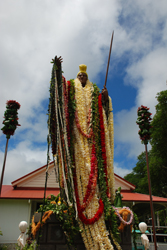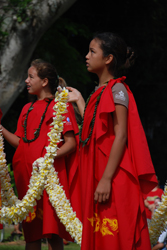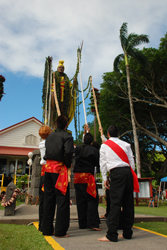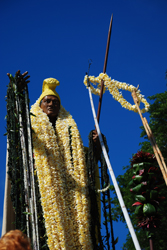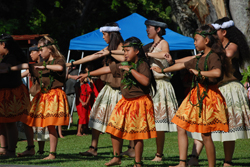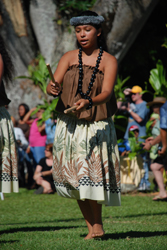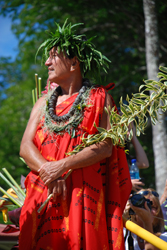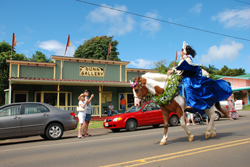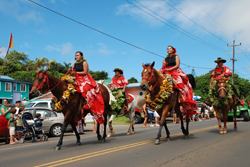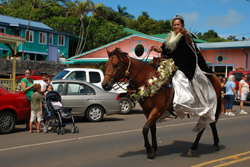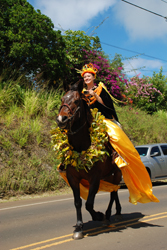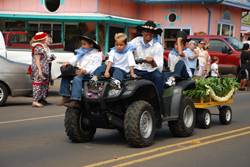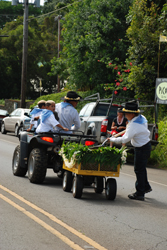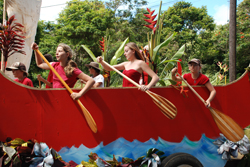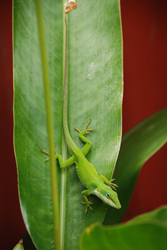Kapaau: Celebrating Kamehameha Day
11 June, 2009, 04:38 am in "USA"
King Kamehameha unified the Hawaiian Islands. He is a true historical figure but the historical facts have probably become very much embroidered by legend. I, of course, prefer the legends.
He was born in Kapa'au and since his mother craved the eyeballs of a tiger shark while she was pregnant, it was fortold he would be the killer of chiefs. This of course rather worried the current chief in power so he tried to kill the baby. His plot was foiled by some named Naioli who took the baby and snuck him through North Kohala. This journey and the events that occured gave the places their names. This I learned fro the MC at the Kamehameha Day festival in Kapa'au. The festival started out with a ceremony where the statue of Kamehameha in the center of town was draped in leis. "How exciting could that be?" I thought. But we showed up for it anyway. It was actually a rather charming ceremony. As we approached the statue we were met by the cool sweet smell of plumeria-- a smell which always says, "Hawaii" to me since at the airport we are usually greeted with plumeria leis being draped over our heads (This time we got pizza which was a to more welcome after the scanty airline meal from the Philippines). The smell was from the rows of leis, each around 20 feet lying on the grass waiting to be draped.
He was born in Kapa'au and since his mother craved the eyeballs of a tiger shark while she was pregnant, it was fortold he would be the killer of chiefs. This of course rather worried the current chief in power so he tried to kill the baby. His plot was foiled by some named Naioli who took the baby and snuck him through North Kohala. This journey and the events that occured gave the places their names. This I learned fro the MC at the Kamehameha Day festival in Kapa'au. The festival started out with a ceremony where the statue of Kamehameha in the center of town was draped in leis. "How exciting could that be?" I thought. But we showed up for it anyway. It was actually a rather charming ceremony. As we approached the statue we were met by the cool sweet smell of plumeria-- a smell which always says, "Hawaii" to me since at the airport we are usually greeted with plumeria leis being draped over our heads (This time we got pizza which was a to more welcome after the scanty airline meal from the Philippines). The smell was from the rows of leis, each around 20 feet lying on the grass waiting to be draped.
A group of young men from the highschool were using long poles to drape the leis on the statue. They were on the ti leaf leis when we arrived. Next came plumeria. Then other flower leis. The MC talked a bit about who the lei was from as well as what they were made of: Kanoa-- yellow orange flowers was the flower of Lanai, Aalili grows most profusely in the Kohala region. There was a hula performance where sacred and traditional hula dances were performed with chants.
One would expect such a list of donors and lei ingredients to be dry but the MC interspersed interesting stories of Kamehameha.
Kapa'au got its name because Naoli had to ford a river and his "kapa" (a cape) got unfastened and "au" (took a bath). In Hawi there was no food so the baby "Ha" (breathed/cried) from "wi" (famine). They ended up taking the soft parts of insects and mixing them with water to feed the baby. In Halaula Naoli's men got frightened because they were being chased and knew if they were caught they'd be killed because they were comitting a "ulu" (red) "hala" (sin). The MC told how all of Kohala plotted to save Kamehameha and would ask if the baby was OK. The response "Ha'lava" (breath of life suffice" gave another place its name.
Alapai's soldiers searched in vain getting no sleep until their eyes were red and swollen. The people of what is now MakaPala made fun of their "maka pala" (eyes red like fruit) The child was eventually brought to Havivi which was a point easy to defend beyond Polalo. This area was named as a challenge "come and get us no!" Impudence.
Kamehameha grew up with inhuman strength. Another local story tells of how after body surfing he lay down on a sun warmed rock to get warm. It felt so nice he decided to carry it home. So he carried it up the hill to his mother's house. Of course, it was a huge stone and now one else could move it. So it stayed at the top of the hill until more recent history. Then people were going to move the stones (probably for development). So the Solomon Brothers decided they needed to move it into town to commemorate Kamehameha. As they trucked it down the road, the stone slid off the truck and they took it as a sign the stone wanted to stay where it was--- they left it there and it remains to this day.
Hawaii is one of those places that legends still thrive. People maintain a closeness to the land that in other places seems to have been lost. I'm not sure everyone is an environmentalist. It's more like everyrone maintains some bit of awe for the land ands is acutely aware of how the land influences them. The land is still a living thing-- growing, shaking and belching out clouds of vog or sending firely fingers of lava into the ocean. The isolation probably also encourages stories. But now the stronger factor is the realization that these stories can be lost. People may get upset by Hawaiian "nationalism" but here you can see it is part of a desperate attempt at saving what hasn't yet been lost when so many other things have been.
Kapa'au got its name because Naoli had to ford a river and his "kapa" (a cape) got unfastened and "au" (took a bath). In Hawi there was no food so the baby "Ha" (breathed/cried) from "wi" (famine). They ended up taking the soft parts of insects and mixing them with water to feed the baby. In Halaula Naoli's men got frightened because they were being chased and knew if they were caught they'd be killed because they were comitting a "ulu" (red) "hala" (sin). The MC told how all of Kohala plotted to save Kamehameha and would ask if the baby was OK. The response "Ha'lava" (breath of life suffice" gave another place its name.
Alapai's soldiers searched in vain getting no sleep until their eyes were red and swollen. The people of what is now MakaPala made fun of their "maka pala" (eyes red like fruit) The child was eventually brought to Havivi which was a point easy to defend beyond Polalo. This area was named as a challenge "come and get us no!" Impudence.
Kamehameha grew up with inhuman strength. Another local story tells of how after body surfing he lay down on a sun warmed rock to get warm. It felt so nice he decided to carry it home. So he carried it up the hill to his mother's house. Of course, it was a huge stone and now one else could move it. So it stayed at the top of the hill until more recent history. Then people were going to move the stones (probably for development). So the Solomon Brothers decided they needed to move it into town to commemorate Kamehameha. As they trucked it down the road, the stone slid off the truck and they took it as a sign the stone wanted to stay where it was--- they left it there and it remains to this day.
Hawaii is one of those places that legends still thrive. People maintain a closeness to the land that in other places seems to have been lost. I'm not sure everyone is an environmentalist. It's more like everyrone maintains some bit of awe for the land ands is acutely aware of how the land influences them. The land is still a living thing-- growing, shaking and belching out clouds of vog or sending firely fingers of lava into the ocean. The isolation probably also encourages stories. But now the stronger factor is the realization that these stories can be lost. People may get upset by Hawaiian "nationalism" but here you can see it is part of a desperate attempt at saving what hasn't yet been lost when so many other things have been.
But back to the holiday. After the lei ceremony was over, the parade from the neighboring town of Hawi arrived. The highlight of the parade were the pa'u riders. These were elegantly costumed riders on beautiful horses wearing carefully crafted leis. I overheard someone mention that they had offered a workshop this year on how to make leis for horses. The results showed that the women had been good students.
Between the riding groups we noticed a little tractor with kids in cowboy clothing. They were pulling a cart whose contents seemed to be carefully protected. We strained to see what they were carrying. The answer became apparent when the kids jumped off the tractor, pulled out shovels and scooped up the droppings of one of the horses.
The parade finished with a canoe float. We finished our day trip with a cappuccino in a cafe with a pretty garden courtyard. We watched lizards scamper across the walls and on the plants.
Comments
- Comments
Powered by My Blog 1.69. Copyright 2003-2006 FuzzyMonkey.net.
Created by the scripting wizards at FuzzyMonkey.net..
(Code modified by Rowshan Dowlatabadi)
Created by the scripting wizards at FuzzyMonkey.net..
(Code modified by Rowshan Dowlatabadi)


